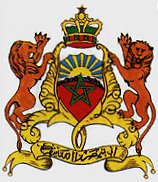|
III. POPULATION
The original population of Morocco was Berber, and about three-quarters of all present-day Moroccans are of Berber
descent. Arabs, who constitute the bulk of the inhabitants of the larger cities, form the second largest ethnic group.
Considerable intermarriage among Arabs, Berbers, and the country's small number of black Africans has broken down
differences among ethnic groups.
Morocco has about 100,000 Europeans, most of them French. The rural population in 1999 was 45 percent of the country's
total.
A. Population Characteristics
The estimated population of Morocco in 2001 was 30,645,305, giving the country an overall population density of 67 persons per sq km (172 per sq mi).
B. Principal Cities
Morocco's capital is Rabat. Other major urban centers are Casablanca, the country's largest city and main seaport;
Marrakech and Fès, both important trade centers; and Tangier, a seaport on a bay of the Strait of Gibraltar.
A. Population Characteristics
The estimated population of
Morocco in 2001 was 30,645,305, giving the country an overall population density of 67 persons per sq km
(172 per sq mi).
C. Religion
Islam is the established state religion of Morocco. Almost the entire population is Sunni Muslim.
The monarch is the supreme Muslim authority in the country.
About 1 percent of the population is Christian, and less than 0.2 percent is Jewish.
.
D. Language
The Berber languages, once dominant throughout Morocco, have declined in importance, and in the early 1990s about
25 percent of the people used Berber as their first language. Many of these people also spoke Arabic, the country's
official language,
which is the primary language of some 75 percent of the population. Numerous Moroccans also use French and Spanish.
E. Education
Schooling is compulsory in Morocco for children between the ages of 7 and 16. Some 73 percent of girls and 95 percent
of boys attend primary school; only 39 percent of secondary-school-age Moroccans actually attend secondary school.
Arabic is the main language of instruction, and French is also used in secondary schools. In 2001 it was estimated
that 69 percent of the population was literate. In the 1996 school year 3.2 million pupils attended primary schools;
1.4 million students were enrolled in secondary and vocational schools.
About 294,500 people were enrolled in
schools of higher education in Morocco in the mid-1990s. Higher education of the traditional type is centered in Fès
at Al Qarawiyin University, which was founded in AD 859. Modern higher education is offered at Mohammed V University
(1957), at Rabat; Mohammed Ben Abdellah University (1974), at Fès; Cadi Ayyad University (1978), at Marrakech; Hassan
II University (1976), at Casablanca; and Mohammed I University (1978), at Oujda. Rabat also has
colleges of fine arts, public administration, agriculture, and economics, and the School of Native Arts and Crafts
(1921) is in Tétouan.
F. Culture
Morocco has felt the influences of several ancient cultures. Excavations have unearthed elements of the Phoenician,
Hellenic, Carthaginian, and Roman civilizations. Christianity spread to this region in Roman times and survived the
Arab invasion, but Arabic influences, which began in the 7th century, were to prove the strongest. The Arabs brought
to Morocco a written language that is still the primary language of business and culture. The western African influence,
seen in dances, spread northward with trade. Among more recent influences, the strongest is that of France.
|
|
|
|
Previous
1
2
3
4
5
NEXT
Back Home
|
| | |
